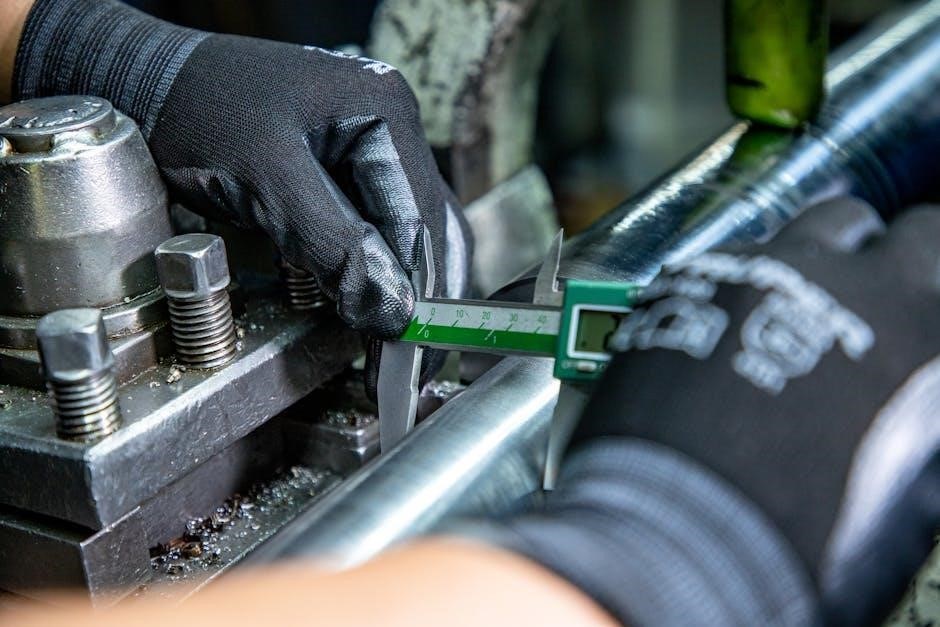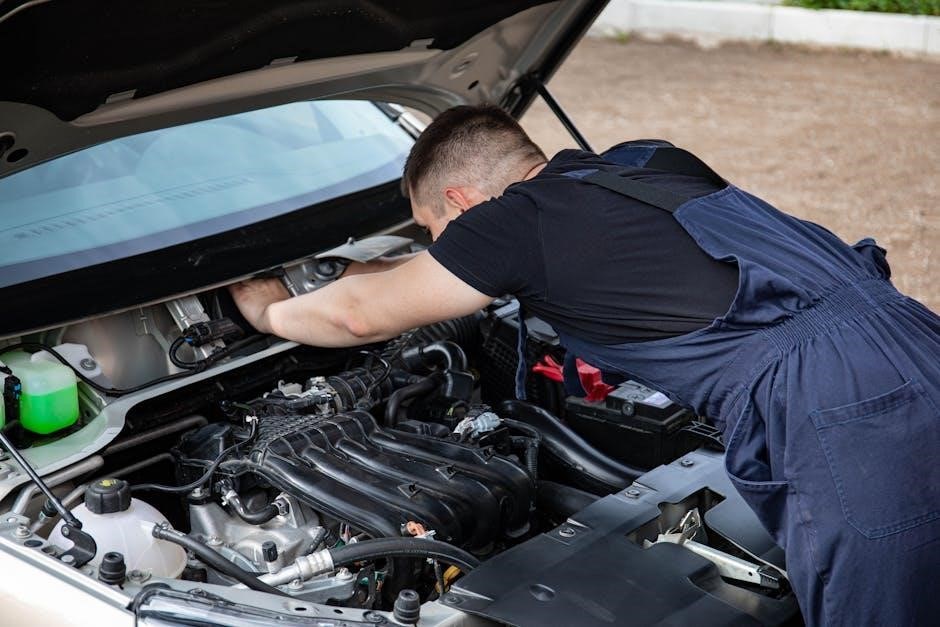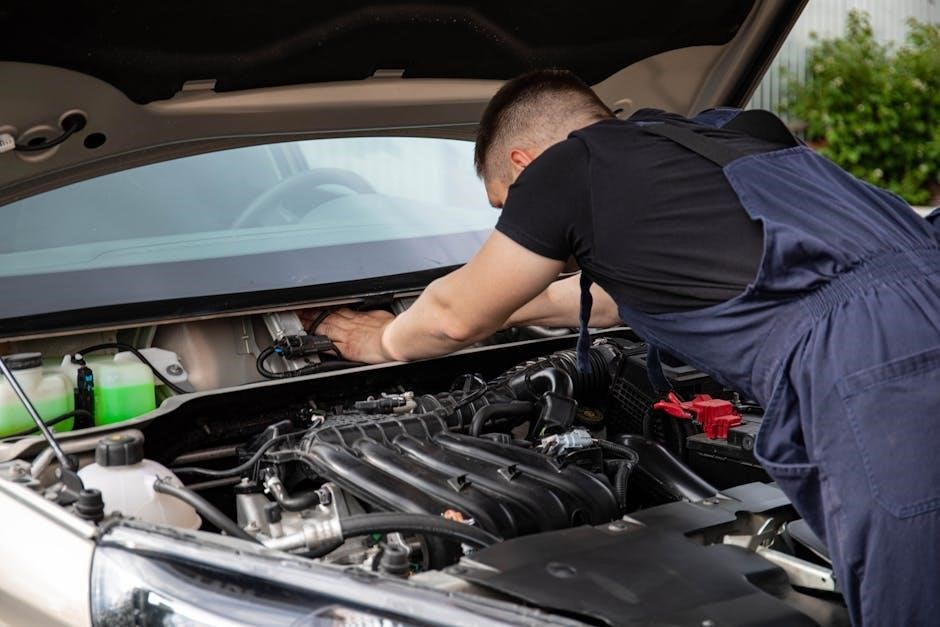The Briggs & Stratton Small Engine Repair Manual empowers users to diagnose, troubleshoot, and repair engines effectively, covering essential maintenance and complex fixes for optimal performance.
1.1. Importance of a Repair Manual for Small Engines
A repair manual is essential for diagnosing, maintaining, and repairing small engines like Briggs & Stratton. It provides detailed instructions, troubleshooting guides, and specifications, ensuring proper maintenance and extending engine lifespan. DIY enthusiasts and professionals rely on these manuals to identify issues, perform repairs accurately, and avoid costly mistakes. With step-by-step procedures, it empowers users to resolve common problems independently, saving time and money. A repair manual is a vital resource for anyone aiming to keep their small engine running efficiently and effectively.
1.2. Overview of Briggs & Stratton Engines
Briggs & Stratton engines are renowned for their reliability and versatility, powering lawn mowers, generators, and small equipment worldwide. With a range of models, from compact single-cylinder to robust V-twin engines, they cater to both residential and commercial needs. Known for durability and performance, these engines are designed to withstand heavy use and varying conditions. Their innovative designs, including advanced fuel systems and cooling technologies, ensure efficient operation. Briggs & Stratton engines are a trusted choice for users seeking dependable power for outdoor and industrial applications, making them a cornerstone in small engine technology.
1.3. Benefits of Using a Repair Manual
A repair manual for Briggs & Stratton small engines offers numerous benefits, including cost savings through DIY repairs, enhanced understanding of engine operation, and improved safety. It provides detailed troubleshooting guides, step-by-step repair procedures, and torque specifications, enabling users to address issues effectively. Regular maintenance schedules and parts lists ensure longevity and optimal performance. By empowering users to handle repairs confidently, the manual reduces reliance on external services, saving time and money while fostering self-sufficiency in engine care.

Key Components of a Briggs & Stratton Small Engine
Briggs & Stratton small engines consist of key components like the carburetor, governor, piston, and cylinder, each vital for proper engine function, ensuring efficiency, performance, and longevity.
2.1. Engine Model Identification
Correctly identifying your Briggs & Stratton engine model is crucial for accurate repairs. Locate the model number, typically found on the engine’s data tag or in the owner’s manual. This number provides specific details about the engine’s specifications, parts compatibility, and repair procedures. Referencing the official repair manual ensures you have the correct information for your particular engine, avoiding potential mismatches and ensuring safety. Accurate identification is the first step in any successful repair or maintenance task.
2.2. Essential Tools for Repair
Having the right tools is essential for effective Briggs & Stratton small engine repair. Commonly needed tools include wrenches, screwdrivers, pliers, and a multimeter for diagnosing electrical issues. A socket set and torque wrench are crucial for precise bolt tightening. Air filter wrenches and spark plug gap gauges are also indispensable. Proper tools ensure repairs are done safely and efficiently, preventing damage to engine components. Always refer to the repair manual for specific tool recommendations tailored to your engine model.
2.3. Safety Precautions
Always prioritize safety when repairing your Briggs & Stratton small engine. Disconnect the spark plug wire to prevent accidental startups. Wear protective gear, including gloves and safety glasses, to shield against debris. Ensure proper ventilation to avoid inhaling harmful fumes. Never work near open flames or sparks, as fuel vapors can ignite. Follow the repair manual’s guidelines for handling hazardous materials and disposing of waste. Keep loose clothing and long hair tied back to avoid entanglement with moving parts. Proper safety practices prevent injuries and ensure a smooth repair process.

Maintenance Schedule for Briggs & Stratton Engines
Regular maintenance is crucial for optimal performance. Follow the schedule for oil changes, air filter cleaning, spark plug replacement, and fuel system checks to ensure reliability and longevity.
3.1. Oil Change and Lubrication
Regular oil changes are essential for maintaining the performance and longevity of your Briggs & Stratton small engine. Use 5W-30 oil for optimal lubrication and protection. Drain the old oil, replace the oil filter, and refill with the recommended type and amount specified in your manual. Proper lubrication prevents overheating, reduces friction, and ensures smooth operation. Always follow the manufacturer’s guidelines for oil viscosity and change intervals to avoid engine damage and maintain peak efficiency throughout the season.
3.2. Air Filter Cleaning and Replacement
Regular maintenance of the air filter is crucial for ensuring optimal engine performance. Remove the air filter and inspect it for dirt or damage. Clean foam filters with mild soap and water, while paper filters should be replaced if dirty. Always reinstall the filter securely to prevent engine issues. Follow the manufacturer’s guidelines for replacement intervals, typically every 50 hours of use. A clean air filter improves fuel efficiency, reduces emissions, and ensures proper airflow, preventing engine surging or rough operation. Neglecting this step can lead to decreased performance and potential engine damage.
3.3. Spark Plug Replacement
Spark plug replacement is essential for maintaining efficient engine performance and fuel efficiency. Begin by disconnecting the spark plug wire and using a spark plug socket to remove the old plug. Inspect the plug for wear or fouling, which can indicate issues like oil leaks or improper air-fuel mixtures; Install a new spark plug with the correct gap specified in your manual. Tighten it securely but avoid over-tightening, which could damage the engine. Regular replacement ensures proper ignition, reduces misfires, and keeps your engine running smoothly. Always refer to the manual for the recommended spark plug type and torque specifications.
3.4. Fuel System Maintenance
Regular fuel system maintenance ensures optimal engine performance and prevents issues like poor starting or rough operation. Begin by cleaning or replacing the fuel filter as specified in the manual. Inspect fuel lines for cracks or damage, replacing them if necessary. Check the carburetor for dirt or blockages, and clean or rebuild it if needed; Ensure the fuel tank is free of debris and properly vented. Always use fresh, high-quality fuel to avoid contamination. Refer to the manual for specific instructions on adjusting or repairing the fuel system components for your Briggs & Stratton engine.

Common Issues and Troubleshooting
Common issues include engines not starting, surging, overheating, or losing power. Troubleshooting involves checking fuel flow, spark plugs, air filters, and governor settings for proper function.
4.1. Engine Not Starting
An engine that won’t start can be due to issues like a faulty spark plug, empty fuel tank, or clogged air filter. Check the fuel cap for blockages and ensure the choke is functioning properly. If the spark plug is dirty or worn, replace it with a new one. Also, inspect the fuel line for leaks or kinks and verify that the carburetor is clean and free of debris. Consult the manual for specific diagnostic steps and solutions to address the root cause effectively.
4.2. Engine Surging or Running Roughly
Engine surging or running roughly can be caused by issues like a faulty governor, clogged carburetor, or improper fuel flow. Check the governor adjustment to ensure it’s set correctly, as outlined in the manual. Inspect the air filter and fuel lines for blockages or damage. A dirty or malfunctioning carburetor may need cleaning or replacement. Additionally, a worn or fouled spark plug can contribute to rough operation. Addressing these common issues can restore smooth engine performance and prevent further damage.
4.3. Overheating Issues
Overheating in Briggs & Stratton engines can stem from blocked air flow, a faulty cooling system, or excessive load. Inspect the air filter and ensure it’s clean or replace it if necessary. Check for blockages in the muffler or cooling fins, as debris can impede heat dissipation. Verify engine oil levels and ensure proper lubrication, as low oil can exacerbate overheating. If issues persist, consult the manual for specific diagnostic steps or consider professional assistance to address potential internal engine damage.
4.4. Loss of Power
Loss of power in Briggs & Stratton engines can result from issues like fuel system blockages, clogged air filters, or worn spark plugs. Check for dirty or fouled spark plugs and replace them if necessary. Inspect the fuel line for kinks or debris and ensure the carburetor is clean and functioning properly. A clogged exhaust system or muffler can also restrict engine performance. Consult the repair manual for specific troubleshooting steps, such as adjusting the carburetor or cleaning the fuel system. Addressing these issues promptly can restore optimal engine performance and efficiency.

Repair Procedures for Briggs & Stratton Engines
This section provides detailed steps for repairing common issues, including carburetor adjustments, governor repairs, and piston replacements, ensuring engines run efficiently and reliably.
5.1. Carburetor Repair and Adjustment
Carburetor issues are common in small engines, often causing poor performance or starting problems. Cleaning or replacing clogged jets and checking float levels can resolve many issues. Adjusting the carburetor involves fine-tuning air-fuel mixtures for proper engine operation. Always use genuine Briggs & Stratton parts to ensure compatibility and reliability. For severe damage, consider rebuilding or replacing the carburetor entirely. Proper reassembly and adjustment are critical to avoid further complications. Always consult the manual for specific torque specs and adjustment procedures to guarantee optimal engine performance and longevity.
5.2. Governor Adjustment and Repair
The governor regulates engine speed, ensuring consistent performance under varying loads. Common issues include surging or rough running, often requiring adjustment. Loosen the governor adjustment screw and turn it to set the correct RPM. Refer to the service manual for specific torque specs and procedures. Proper adjustment prevents engine damage and ensures smooth operation. If the governor is damaged, replacement may be necessary. Always follow safety guidelines and use genuine parts for reliability. Adjusting the governor correctly restores optimal engine performance and prevents further complications.
5.3. Piston and Cylinder Repair
Piston and cylinder repair involves diagnosing and addressing issues like scoring, excessive wear, or seized components. Inspect the piston for damage and measure cylinder walls for wear. If damaged, replace the piston ring set and resurface or replace the cylinder. Use genuine Briggs & Stratton parts for reliability. Proper torque specs, found in the repair manual, ensure a secure assembly. Lubricate moving parts thoroughly before reassembly. Addressing these issues promptly prevents further engine damage and restores performance. Always follow safety guidelines and consult the manual for specific instructions.
5.4. Muffler and Exhaust System Repair
Muffler and exhaust system repair addresses issues like leaks, corrosion, or excessive noise. Inspect the muffler for rust or holes, replacing it if damaged. Clean or replace the spark arrestor to ensure proper exhaust flow. Check exhaust pipes for blockages or damage, ensuring they are securely attached. Use the repair manual to identify compatible parts. Proper installation prevents carbon monoxide leaks and maintains engine efficiency. Tighten all connections firmly and test the system for leaks after repair. Regular maintenance helps extend the system’s lifespan and ensures safe operation.

Advanced Repair Techniques
Advanced techniques cover complex repairs like crankshaft replacement, valve adjustments, and electrical diagnostics, requiring detailed guidance and precision for optimal engine performance and longevity.
6.1. Crankshaft and Camshaft Replacement
Replacing the crankshaft and camshaft in a Briggs & Stratton engine requires precision and specialized tools. Ensure the engine is disassembled properly, and align the components meticulously. Torque specifications must be followed strictly to avoid damage. Lubricate moving parts before reassembly and check for any wear on connecting rods or bearings. Consult the manual for specific instructions, as procedures vary by engine model. Proper alignment and secure fastening are critical for smooth operation and longevity of the engine. Always use genuine Briggs & Stratton parts for reliability.
6.2. Valve Adjustment and Replacement
Valve adjustment and replacement are critical for maintaining optimal engine performance. Begin by removing the valve cover and inspecting the components. Adjust the valve clearance using a feeler gauge, ensuring it matches the specifications in the manual. If replacement is needed, install new valves and seats, and lap them for a proper seal. Reassemble the engine and test for leaks. Proper valve function ensures efficient combustion and prevents engine damage. Always refer to the repair manual for precise torque and clearance settings specific to your engine model.
6.3. Electrical System Diagnostics
Diagnosing electrical system issues in Briggs & Stratton engines involves checking components like spark plugs, ignition coils, and wiring. Start by ensuring all connections are secure and free from corrosion. Use a multimeter to test voltage and continuity. If the spark plug isn’t firing, inspect the ignition coil and module. Consult the repair manual for specific troubleshooting steps. Always disconnect the battery before working on electrical components. Proper diagnostics ensure reliable engine operation and prevent further damage. Regular maintenance can help identify electrical issues early, reducing downtime and repair costs.
6.4. Fuel Pump and Injector Repair
Fuel pump and injector repair is critical for maintaining proper engine performance. Start by consulting the repair manual to locate and remove the fuel pump. Inspect for debris or blockages and clean or replace as needed. For injectors, use specialized tools to remove and test flow rates. Replace faulty injectors to ensure efficient fuel delivery. Regular maintenance, such as cleaning or replacing fuel filters, can prevent issues. Always follow safety guidelines when handling fuel systems to avoid hazards. Proper repair ensures optimal engine power and fuel efficiency, reducing the risk of costly damage over time.

Safety Guidelines for Engine Repair
Safety is crucial when repairing small engines. Always wear protective gear, ensure proper ventilation, and follow fire prevention measures. Keep tools organized and avoid hazardous materials mishandling.
7.1. Proper Use of Tools and Equipment
Using tools and equipment correctly is vital for safe and effective engine repair. Always select the right tool for the task to avoid damaging components or causing injuries. Ensure tools are in good condition and properly calibrated. Wrenches, screwdrivers, and pliers are essential for most repairs, while specialized tools like torque wrenches are critical for precise adjustments. Regularly inspect tools for wear and tear, and store them in an organized manner to prevent misplacement. Improper tool usage can lead to costly mistakes or accidents, emphasizing the need for careful handling and adherence to manufacturer guidelines.
7.2. Handling Hazardous Materials
When working with small engines, handle hazardous materials like gasoline, motor oil, and coolant with care. Always wear gloves and goggles to protect against skin and eye irritation. Ensure good ventilation to avoid inhaling fumes. Store chemicals in approved containers and follow disposal guidelines to prevent environmental harm. Keep flammable liquids away from heat sources and open flames. Refer to the repair manual for specific safety precautions related to your engine’s materials. Proper handling prevents accidents and ensures a safe working environment.
7.3. Fire Safety and Prevention
Fire safety is crucial when repairing small engines. Keep a fire extinguisher nearby and ensure it’s easily accessible. Avoid smoking or using open flames near flammable materials like gasoline or oil. Store rags and other combustible items in a sealed container. Regularly inspect fuel lines and connections for leaks to prevent ignition sources. Ensure your workspace is well-ventilated to reduce the risk of vapors igniting. Always follow the repair manual’s guidelines for handling volatile substances to maintain a safe environment during repairs.
7.4. Workspace Setup and Organization
A well-organized workspace is essential for efficient and safe repairs. Start by clearing a clean, flat surface for your work area. Use a vice to secure the engine or components, ensuring stability during repairs. Keep tools and parts organized in labeled trays or containers to avoid misplacement. Proper lighting is crucial; use a bright, adjustable light source to illuminate your work. Store hazardous materials separately and keep a fire extinguisher nearby. A tidy workspace reduces stress and increases productivity, helping you focus on the repair tasks at hand.

Resources for Briggs & Stratton Engine Repair
Official manuals, online forums, and video tutorials provide comprehensive guides for repairs. Local dealers and repair shops offer additional support and genuine parts for optimal results.
8.1. Official Briggs & Stratton Manuals
Official Briggs & Stratton manuals are essential resources for small engine repair. They provide detailed diagrams, torque specifications, and step-by-step instructions for maintenance and troubleshooting. These manuals cover various engine models, ensuring accurate repairs. Users can find specific guides for carburetor adjustments, governor settings, and piston repairs. Available online or through authorized dealers, they are indispensable for DIY enthusiasts and professionals alike. Regularly updated, they reflect the latest technical advancements and repair practices.
8.2. Online Forums and Communities
Online forums and communities offer valuable resources for Briggs & Stratton small engine repair. Platforms like Reddit, specialized repair forums, and social media groups provide spaces for discussing common issues, troubleshooting, and sharing repair tips. Users can access advice from experienced mechanics and DIY enthusiasts, as well as links to repair manuals, video tutorials, and parts suppliers. These communities often include detailed discussions on carburetor adjustments, governor settings, and piston repairs, making them a vital resource for both novices and professionals.
8.3. Video Tutorials and Guides
Video tutorials and guides provide visual step-by-step instructions for repairing Briggs & Stratton small engines. Platforms like YouTube host numerous channels dedicated to engine repair, offering detailed demonstrations of tasks such as carburetor cleaning, spark plug replacement, and governor adjustment. These videos often include close-ups of tools and techniques, making complex repairs more accessible. Additionally, official Briggs & Stratton channels and experienced mechanics share tips, ensuring viewers can confidently tackle various maintenance and repair projects with clarity and precision.
8.4. Local Repair Shops and Dealers
Local repair shops and authorized Briggs & Stratton dealers offer hands-on expertise and genuine parts for small engine maintenance and repair. These professionals provide personalized service, diagnosing issues accurately and ensuring repairs meet factory standards. Many dealerships also host workshops or offer online resources, helping DIY enthusiasts gain practical knowledge. By supporting local businesses, users can access reliable assistance, extending their engine’s lifespan and performance. This direct support is invaluable for those seeking immediate solutions or specialized guidance.
The Briggs & Stratton Small Engine Repair Manual provides comprehensive guidance, empowering users to maintain and repair engines effectively, ensuring longevity and optimal performance with clear, detailed instructions;
9.1. Summary of Key Points
The Briggs & Stratton Small Engine Repair Manual is an essential resource for enthusiasts and professionals, offering detailed guidance on troubleshooting, maintenance, and advanced repair techniques. It emphasizes regular maintenance, safety protocols, and proper diagnostic methods to ensure engine longevity. The manual covers a wide range of topics, from basic tune-ups to complex overhauls, providing clear instructions and specifications. By following the manual, users can enhance their DIY repair skills and keep their engines running efficiently. It also highlights the importance of using genuine parts and adheres to manufacturer recommendations for optimal performance and safety.
9.2. Final Tips for Successful Repair
For successful small engine repair, always refer to the Briggs & Stratton repair manual for specific torque specs and adjustments. Use genuine parts to ensure compatibility and longevity. Regularly inspect and clean components like air filters and spark plugs to prevent issues. Keep a well-organized workspace and label removed parts for easy reassembly. Follow safety guidelines to avoid injuries and damage. Troubleshoot systematically, starting with simple fixes before moving to complex procedures. If unsure, consult online forums or seek professional assistance. Regular maintenance is key to preventing major repairs and extending engine life.
9.3. Importance of Regular Maintenance
Regular maintenance is crucial for extending the life and performance of Briggs & Stratton small engines. By adhering to the recommended maintenance schedule, users can prevent common issues like engine surging or rough running. Simple tasks such as oil changes, air filter cleaning, and spark plug replacement can significantly improve reliability. Neglecting routine upkeep often leads to costly repairs and downtime. Always refer to the repair manual for specific guidelines tailored to your engine model. Consistent care ensures optimal performance, fuel efficiency, and longevity of the engine. Regular maintenance is an investment in your equipment’s durability and functionality.

Additional Tips for DIY Enthusiasts
Keep a repair journal, store parts safely, and practice preventive maintenance. Referencing the manual ensures accurate fixes, saving time and reducing errors during DIY projects.
10.1. Keeping a Repair Journal
Maintaining a detailed repair journal is invaluable for DIY enthusiasts. Record the date, engine model, and specific issues encountered. Note the steps taken, parts replaced, and outcomes. This log helps track patterns, prevents recurring problems, and serves as a reference for future repairs. Include photos or diagrams for clarity. Over time, the journal becomes a personalized guide, ensuring efficient troubleshooting and minimizing guesswork. It also helps in sharing knowledge with others or consulting professionals when needed, making it a practical tool for small engine maintenance and repair. Regular updates ensure accuracy and completeness.
10.2. Storing Parts and Tools
Proper storage of parts and tools is crucial for efficient engine repair. Use labeled bins or cabinets to organize components, ensuring easy access. Store small parts like screws and gaskets in sealed containers to prevent loss. Keep tools in a designated area, such as a toolbox or pegboard, to maintain order. Clean and dry all parts before storage to avoid corrosion. Regularly review stored items to discard outdated or damaged components. A well-organized workspace reduces repair time and minimizes the risk of misplaced items, ensuring a smoother DIY experience for small engine maintenance and repair.

10.3. Preventive Maintenance Practices
Regular preventive maintenance is vital for extending the lifespan of your Briggs & Stratton small engine. Schedule routine oil changes, air filter cleaning, and spark plug replacements to ensure optimal performance. Inspect fuel lines and connections for leaks or damage. Check the muffler and exhaust system for blockages. Lubricate moving parts and tighten loose bolts periodically. Keep the engine clean to prevent debris buildup. By adhering to these practices, you can avoid costly repairs and ensure reliable operation of your engine throughout the season. A well-maintained engine also enhances safety and efficiency, making your DIY projects more enjoyable and stress-free.
